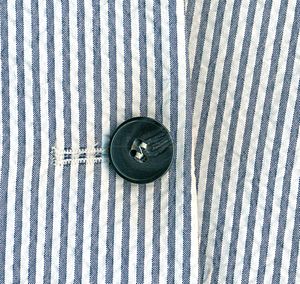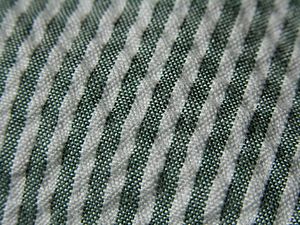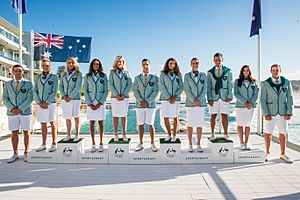Seersucker facts for kids
Seersucker is a special kind of fabric, usually made from cotton. It's known for its unique bumpy or "puckered" look, which makes it feel a bit like "milk and sugar" – smooth in some parts and rough in others. This name actually comes from Persian words meaning exactly that!
This fabric is woven in a clever way so that some threads bunch up. This creates the wrinkled texture. Because of this bumpy surface, seersucker fabric doesn't stick to your skin, especially when it's hot or you're sweaty. This helps air move around and keeps you cooler. Plus, a great bonus is that you don't need to iron it!
People often use seersucker to make clothes for warm weather, like suits, shorts, shirts, dresses, and robes. In the United States, you'll often see it in blue and white stripes, but it comes in many other colors too.
Contents
History of Seersucker Fabric
Seersucker became popular in places with hot weather, like British India, when Britain had colonies there. When it came to the United States, it was used for many types of clothes. In the hot and humid Southern states, seersucker suits were a favorite for gentlemen in the summer, especially before air conditioning was common.
During the American Civil War, seersucker was a cheap but strong material. It was used to make bags called haversacks and even the loose pants for Confederate soldiers known as Zouaves.
From the mid-Victorian era until the early 1900s, seersucker was also called "bed ticking." This was because it was widely used for mattresses, pillow cases, and nightshirts during hot summers in the Southern US and British colonies.
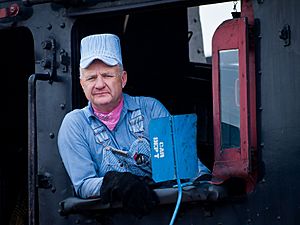
At first, seersucker was mostly worn by people who didn't have a lot of money in the U.S. But in the 1920s, college students started wearing it to be different, almost like a "reverse snobbery" trend.
Seersucker was comfortable and easy to wash, which made it a good choice for uniforms. During World War II, Captain Anne A. Lentz chose it for the summer uniforms of the first female Marines. From the 1940s, nurses and hospital volunteers also wore uniforms made from a red and white seersucker, often called "candy stripe."
Hickory Stripe Seersucker
In the days of the Old West, a strong, dark blue seersucker called "hickory stripe" was used. It was popular for the overalls, work jackets, and caps worn by train engineers and railroad workers like George "Stormy" Kromer and Casey Jones. Later, butchers and gas station employees also wore it. This cotton fabric was tough like denim, cheap to make, and helped keep workers cool in the hot cab of a steam locomotive. Even today, some train drivers wear caps based on these old "railroad stripe" designs.
Seersucker in Fashion Trends
Around 1909, a clothing maker from New Orleans named Joseph Haspel, Sr. started making men's suits from seersucker. These suits quickly became popular in the Southern states because they were much more comfortable and practical than other suits in the hot, humid climate.
In the 1950s, cheap "railroad stripe" overalls were popular for young boys before they started wearing jeans. At the same time, many adults in the Southern and Southwestern US continued to wear seersucker for dressier occasions. College professors often wore full seersucker suits with red bow ties. However, students in the 1950s and today often wear just one seersucker item, like a blazer, with khaki pants. Famous brands like Brooks Brothers and Joseph Haspel made seersucker clothing back then.
In the 1970s, seersucker pants became popular among young African Americans in cities who wanted to connect with their country heritage. The fabric also made a comeback for teenage girls in the 1990s and again in the 2010s.
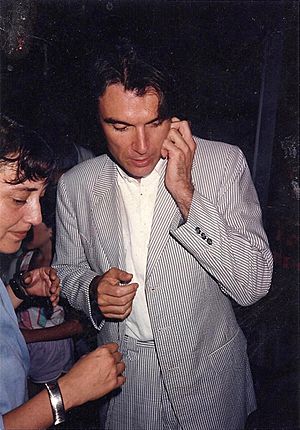
Starting in 1996, the U.S. Senate used to have a "Seersucker Thursday" in June. On this day, senators would wear traditional Southern clothing. This tradition stopped in 2012 but was brought back in 2014.
Seersucker Fashion: 2010 to Today
From 2012 onwards, seersucker blazers and pants became popular again for American men. This was partly because of a renewed interest in "preppy" clothing and the style shown in the 2013 movie The Great Gatsby. While light blue and dark blue stripes were still the most common, you could also find seersucker in green, red, black, grey, beige, yellow, orange, purple, pink, and brown. The classic two-button blazer got a more modern, slimmer fit. Since 2010, "Seersucker Social" events have been held in major US cities. People wear vintage clothes and ride old-fashioned bicycles, like a summer version of a "Tweed Run."
At the 2016 Summer Olympics in Brazil, the Australian Olympic team wore green and white seersucker blazers and Toms Shoes instead of their usual dark green uniforms. Around the same time, many young women in America wore seersucker pants, skirts, shoes, blouses, and even bikinis as casual fashion.
How Seersucker Fabric is Made
Seersucker is made using a method called "slack-tension weave." This means that some threads are kept looser than others during weaving. The stripes always run along the length of the fabric. Today, only a few companies make seersucker because it's a slower process, which makes it more expensive to produce.
Images for kids
-
David Ferriero, speaking at Wikimania 2012, wearing a seersucker suit
-
Members of the United States Senate on Seersucker Day 2019
See also
 In Spanish: Mil rayas para niños
In Spanish: Mil rayas para niños


